

 The South African
The South African
Major Darrell D. Hall
There are many German guns of World War I in the museums, and beside the war memorials, of South and South West Africa. Not only do they represent many of the types encountered by South African troops during that war; they also illustrate design developments in artillery at the end of the 19th Century, and early 20th Century.
The Germans introduced rifled breech-loading artillery in the l860s. After the Franco-Prussian War came ‘Material C/73’. This was in two versions — the light 7,85 cm equipment for horse artillery, and the heavy 8,8 cm equipment for field artillery. These were normally described as 8 cm and 9 cm respectively.
Having two separate guns for horse and field artillery caused problems in the field, especially in connection with ammunition supply. When, in 1888, improvements in material made a lighter gun possible, the larger 9 cm calibre was adopted for both horse and field; this was the C/73/88. Then came the C/73/91 — the same gun but with an improved barrel of nickel steel.
This was followed by the 7,7 cm C/96. The ‘C’ prefix was not always used; this and later guns becoming ‘Model 96’ etc. This gun incorporated several improvements, notably in the breech mechanism, and a traversing system was included for the first time.
At about this time, a light field howitzer, the 10,5 cm Model 98, was adopted. The Germans had not been keen to introduce a new type of equipment, hoping that they would be able to get by on field guns alone. Developments in other European armies and unsuccessful experiments with field artillery ammunition forced them to take this step.
In the early years of the 20th Century, the Germans discovered that their two major rivals, Britain and France, had left them behind in gun design. France had developed a superior field gun. But it must have been infuriating for the Germans to discover that Britain had bought a large number of guns from Ehrhardt, a German manufacturer, as a stopgap pending the production of their new 13 and 18 pounder guns. The Ehrhardt gun, with its ‘long recoil’, was better than the gun in use with the German army at the time the 7,7 cm C/96. This gun was mounted on a rigid carriage and had a very rudimentary recoil system.
The Germans, therefore, rapidly updated their field artillery and produced the new 7,7 cm Field Gun Model 96 n.A. (‘neuer Art’ — new pattern). The light field howitzer, the 10,5 cm Model 98, was also on a rigid carriage, so this was improved too, and a recoil system incorporated. It became the Model 98/09.
German artillery in 1914 was organized into field artillery and foot artillery branches. The former consisted of the light field guns and howitzers just described, which were organic to infantry and cavalry divisions. The latter designation applied to heavier artillery which normally came under corps or army command.
This foot artillery consisted of about 25% guns and 75% howitzers. These ranged in calibre from 9 cm to 42 cm. The most common calibres were 10 cm, 13 cm and 15 cm. About 5000 of the howitzers were of 15 cm calibre.
In their overseas colonies, the Germans used the latest guns available, as well as obsolete guns which could not be replaced because of the distance from the Fatherland. Of particular interest are the naval guns which were used in the East African campaign. Never intended for land service, the use of these guns typifies the energy and ingenuity of the Germans.
Towards the end of the 19th Century, Krupp produced several 6 cm and 7 cm mountain-guns, although mountain artillery was not part of the German army. Ehrhardt was also active in this field, and his mountain gun illustrates design improvements, notably in its recoil system, which put it ahead of all others when it appeared in 1904.
The guns to be described are listed below. All can be seen in South or South West Africa to-day:
| German designation: | 3,7 cm Maschinenkanone | |
| Weight of projectile: | 0,45 kg | (1 lb) |
| Muzzle velocity: | 550 m/sec | (1 800 ft/sec) |
| Calibre: | 3,7 cm | (1,46 in) |
| Maximum range: | 2 750 m approx | (3 000 yds approx) |
| Weight in action: | 757 kg approx | (1 665 lbs approx) |
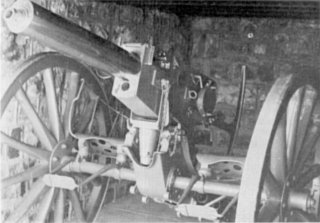
3.7 cm Automatic Machine Gun (Pom-pom) -
The Krupp
version of the original Boer War Pom-pom.
Later naval versions on deck mountings were produced. At the beginning of World War I modifications were made to allow these guns to be used against aircraft. The British Army also mounted pom-poms on high-angle carriages for the same reason. The Belgian and German armies did likewise.
The German pom-pom was made by Krupp and this is one of those guns. There were four in German West, the name by which South African troops came to know South West Africa. These guns were captured at Windhoek.
Pom-poms were not widely used in the war. As anti-aircraft guns they were soon replaced by guns specifically designed for that purpose.
| German designation: | 7cm Gebirgskanone L/14 M 98 |
(abbreviated: 7 cm Geb K L/14 M 98) |
| Weight of projectile: | 4,3 kg | (9,48 lb) |
| Muzzle velocity: | 280 m/sec | (910 ft/sec) |
| Calibre: | 7 cm | (2,76 in) |
| Maximum range: | 3 800 m | (4 117 yds) |
| Traverse: | Nil | |
| Elevation: | - 10° to | +20° |
| Weight in action: | 280 kg | (617 lbs) |
In the 19th Century, mountain artillery was a feature of some, but not all, European armies. Britain, for example, was active in this field. Mountain guns were prominent in her many campaigns in India. Mountainous countries, such as Austria-Hungary, also had their mountain artillery.
Krupp, therefore, produced mountain guns for sale to interested countries and for use in some of Germany’s overseas colonies. Between 1875 and 1907 there were no less than eight 6 cm and 7 cm Krupp mountain guns.
After 1902, recoil systems were incorporated, but the earlier guns, such as this 7 cm Model 98, were on rigid carriages, but this was one of the last with no recoil system.
China ordered a number of these guns from Krupp in about 1900, but the Boxer Rebellion broke out while manufacture was still in progress. The German government commandeered the guns and equipped two batteries of the German Expeditionary Force for China with them. Later some found their way to German West.
The gun was of steel construction with a horizontal sliding breech block, incorporating a cocking mechanism similar to the 7,7 cm Field Gun Model 96 n.A.
The trail was in two parts, the rear section being narrow to enable it to slide into the forward section on assembly. Recoil was limited by rope brakes, and a detachable spade could be fitted if required. There was no shield. Laying was by tangent sight. Shrapnel ammunition only was provided.
The gun could be towed by mules in tandem, for which a pair of shafts was provided. Alternatively, it could be stripped down to either three or four mule-pack loads.
In 1914, there were six 7 cm and four 6 cm mountain guns of Krupp manufacture in German West.
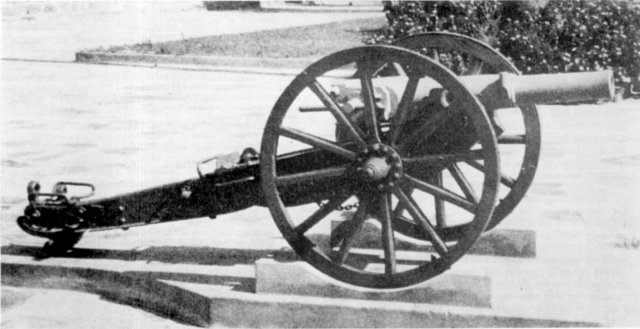
7 cm Mountain Gun Model 98 - This 1898
model Krupp gun was captured in German West.
| German designation: | 7,5 cm Gebirgskanone L/17 M 08 |
(abbreviated: 7,5 cm Geb K L/17 M 08) |
| Weight of projectile: | 5,3 kg | (11,68 lb) |
| Muzzle velocity: | 300 m/sec | (984 ft/sec) |
| Calibre: | 7,5 cm | (2,95 in) |
| Maximum range: | 5 750 m | (6 288 yds) |
| Traverse: | 2,50 left and right | |
| Elevation: | -7° to +30° -7° to +38,5° |
with long trail with short trail |
| Weight in action: | 529 kg | (1 166 lbs) |
Herr Ehrhardt of the ‘Rheinische Metallwáaren und Maschinenfabriek’ of Dusseldorf was another prominent German gun designer at the turn of the century. The first ‘long recoil’ gun of the British Army (15 pr QF) was an Ehrhardt gun.
Although mountain guns were available, there were no mountain artillery units in the pre-war German Army. In 1904, Ehrhardt produced his version — an important gun in the history of gun design.
Guns were now appearing with ‘controlled recoil’ systems. This meant that the amount of recoil was the same whatever the elevation, and this had its disadvantages. It meant that elevation was limited as, at higher angles, the breech would recoil into the ground or the trail. Ehrhardt and others realised that the higher the angle, the less the need for a long recoil, as the gun was more stable in this position. A ‘variable recoil’ was, therefore, the answer — long recoil at low angles of projection, short recoil at high.
This mountain gun was his first so-designed, and it is possible that it was the first field equipment with variable recoil which is a normal feature in modern guns.
There were various versions of this gun. Improvements came in 1906. The model used in German West was produced in 1908.
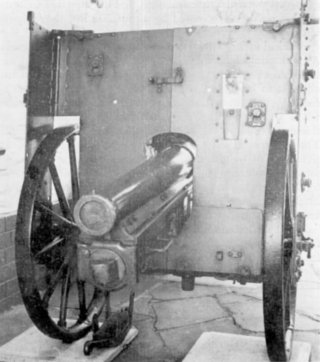
7.5 cm Mountain Gun Model 08 -
Note how the shield has been folded
forward for movement, and how
it can be dismantled.
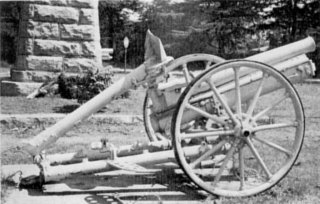
7.5 cm Mountain Gun Model 08 -
The shield has been removed,
and the
trail is folded forward for movement.
The trail had two seats. These were not for the comfort of the detachment. A major factor in the stability of a gun is its weight. These seats enabled the effective weight of the gun to be increased by about 300 lbs, the weight of two men.
A shield is normally fitted between the wheels of a gun. A mountain gun is small so, to be effective, the shield in this case extended outside the wheels and was hinged to allow it to be folded back. As the gun had an effective recoil system, the detachment could remain on the gun when it was fired. The original 1904 version had a shield 3,5 mm thick. This was then reduced to 3 mm. This difference may seem insignificant but it made a difference in weight of 22 lb, important in a pack equipment where every pound counts. There was a penalty — the 3,5 mm shield would keep out a German ‘S’ bullet fired from 350 yds, while the 3 mm shield would only keep out the bullet from 600 yds.
Ehrhardt mountain guns were used mainly in the German colonies. Some went to the Portuguese for use in Angola in 1906; others went to the Dutch for use in the Far East. Then there were these which were used in German West.
| German designation: | 8 cm leichtes Feldgeschutz Material C/73 |
(abbreviated: 8 cm FK C/73) |
| Weight of projectile: | Shell 5,07 kg Shrapnel 5,53 kg Case 5kg |
(11,17 lb) (12,19 lb) (11,02 lb) |
| Muzzle velocity: | 465 m/sec | (1 525 ft/sec) |
| Calibre: | 7,85 cm | (3,09 in) |
| Maximum range: | Shell 6 800 m Shrapnel 2 500 m Case 400 m |
(7 436 yds) (2 734 yds) ( 437 yds) |
| Traverse: | Nil | |
| Elevation: | -15° to | +l8° |
| Weight in action: | 892,5 kg | (1 967 lbs) |
This is the light version of the Material C/73 which was introduced for horse artillery after the Franco-Prussian War. As such, it was not intended to have axletree seats but some guns, such as this one, were fitted with seats for field artillery use.
The gun was of steel construction, strengthened by a steel jacket at the breech end. Breech closing was by means of a sliding cylindrical wedge. It was made gas-tight by means of a steel ring in the breech end of the chamber and a steel removable plate on the face of the breech block. This fitted against the expanding steel ring. This was a weak point as irregular wear meant frequent changing.
Ignition was through a channel constructed transversally through the wedge (or breech block), the housing projecting above the breech.
Wheel brakes were used to control recoil but they were not really adequate. Percussion and time fuzes were available, but shrapnel range was short.
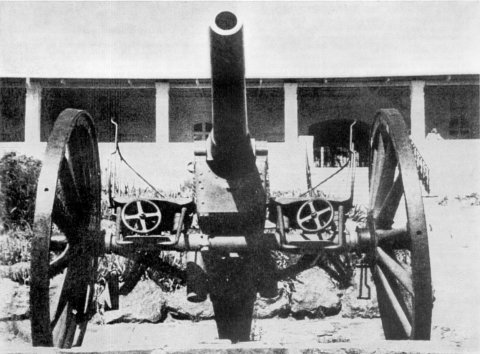
8 cm Light Field Gun Model C/73 -
Note that axletree seats have been fitted.
4 x 3,7 cm Pom-poms
12 x 7,5 cm Geb K L/17 M 08
22 x 7,7 cm FK 96
8 x 7,7 cm FK 96 n.A.
4 x 10,5 cm le FH 98
There were also some smaller guns. The 6 cm and 7 cm mountain guns have already been mentioned. In addition there were three 5,7 cm QF guns and three 3,7 cm revolver guns, but no details are known about these.
| German designation: | 9 cm Feldgeschutz
Material C/73/88 |
(abbreviated: 9 cm FK C/73/88) |
| Weight of projectile: | Shell 7,5 kg Shrapnel 7,42 kg |
(16,53 lb) (16,35 lb) |
| Muzzle velocity: | 442 m/sec | (1 450 ft/sec) |
| Calibre: | 8,8 cm | (3,46 in) |
| Maximum range: | Shell 6 500 m Shrapnel 6 600 m |
(7 108 yds) (7 218 yds) |
| Traverse: | Nil | |
| Elevation: | -15° to | +l8° |
| Weight in action: | 1 308 kg | (1,29 tons) |
Tests carried out between 1886 and 1888 showed that the 8,8 cm barrel could be made lighter without affecting performance adversely. This was done by removing metal at the breech block and trunnions. Consequently the entire German field artillery could receive a uniform 8,8 cm gun. Previously field artillery had an 8,8 cm gun but, for mobility, horse artillery had a lighter 7,85 cm gun. These were normally referred to as 9 cm and 8 cm respectively.
Trouble was then experienced with the barrel of the new gun. Tests continued and in 1891 a new barrel of nickel steel was adopted. The improved gun was known as the C/73/9 1. In appearance it was the same as the C/73/88.
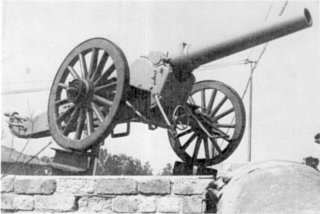
The Boksburg gun - Identification is uncertain.
This may well be
the 9 cm C/73/88 carriage,
but the calibre is 8.7cm. (See the text)
Taking advantage of the experience gained in manufacturing guns for the German Army, in 1874 Krupp was able to offer his guns for sale to other countries. The barrels of these export guns differed only in calibre from those of the regular German artillery for example, the 7,85 cm and 8,8 cm calibres became 7,5 cm and 8,7 cm respectively.
The Boksburg gun has a calibre of 8,7 cm. It was probably one of Krupp’s export models, sold possibly to the Orange Free State before the Boer War. There are photographs of similar guns with OFS forces during the war. To complicate matters, however, there are references to old Krupps of 7,5 cm calibre but none to Krupps of this larger calibre.
It is impossible to say anything positive about the carriage. The author believes it may be that of the C/73/88, but has been unable to confirm this point. It is hoped to provide more information about this gun in a later issue of the Journal.
What appears certain is that the gun was not used in either the German West or German East campaigns. It is included here because, as a type, it fills the gap between the 8 cm C/73 and the 7,7 cm FK 96 which follows.
| German designation: | 7,7 cm Feldkanone M 96 |
(abbreviated: 7,7 cm FK 96) |
| Weight of projectile: | 6,85 kg | (15,04 lb) |
| Muzzle velocity: | 465 m/sec | (1 525 ft/sec) |
| Calibre: | 7,7 cm | (3,03 in) |
| Maximum range: | 8 000 m Time fuze 5 000 m m |
(8 750 yds) (5 468 yds) |
| Traverse: | 4° left and right | |
| Weight of gun and limber packed: | 1 728 kg | (1,7 tons) |
This gun replaced the 9 cm Models C/73/88 and C/73/91 as the field artillery equipment of the German Army at the end of the 19th Century. It is interesting to note that the Krupp 7,5 cm field gun, used by the Boer forces in South Africa, was never the standard field gun of the German Army, although it was an effective weapon and was preferred to the 7,5 cm Creusot.
At about this time the 7,7 cm FK 96 was accepted for German field artillery. It featured some interesting improvements when compared with the 7,5 cm model mentioned above and the earlier 9 cm equipments. It had a two-motion breech mechanism which included cocking, firing and cartridge case extraction mechanism. The gun could be traversed through 80 independently of the carriage. It had an improved tangent sight, incorporating a clinometer which did not have to be removed on firing. Recoil was limited by a wire rope brake and a trail spade. This had the effect of making the gun ‘stand on its hind legs’ when fired, so the trail spade could not be used unless there was zero traverse, as otherwise the gun would turn over. When not in use, this spade was folded over the trail eye and out of the way.
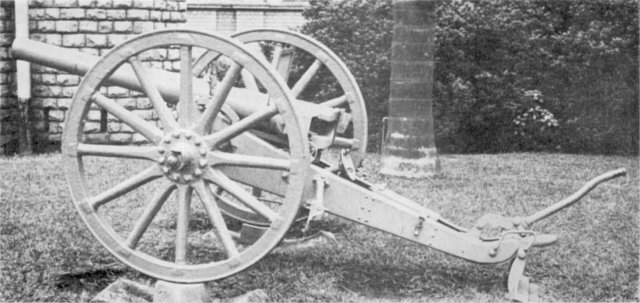
7.7 cm Field Gun Model 96 - This was the standard
field gun at the beginning of the 20th Century.
Note how the spade has been folded over ready for use.
When not required, it was pivoted forward over the trail.

7.7 cm Field Gun Model 96 - Note the shield
which was not normally fitted on this gun.
The large cut-away portion allowed laying
by tangent sight.
In 1897 the French adopted their famous ‘75’, a gun which put them well ahead of all European armies. If a European war had broken out soon after the Boer War, it would have found the British Army with the 15 pr Ehrhardt, a stopgap equipment bought from Germany; and the German Army with this gun, obsolete in design. It was fortunate for both the British and the Germans that the war did not start until 1914.
Obsolete the 7,7 cm FK 96 may have been, but nevertheless in colonies, such as German West Africa, it was still in service in 1914, and most of the examples to be found in South Africa to-day were captured in that campaign.
| German designation: | 7,7 cm Feldkanone M 96
neuer Art |
(abbreviated:
7,7 cm FK 96 n.A.) |
| Weight of projectile: | 6,85 kg | (15,04 lb) |
| Muzzle velocity: | 465 m/sec | (1 525 ft/sec) |
| Calibre: | 7,7 cm | (3,03 in) |
| Maximum range: | 7 800 m Time fuze 5 000 m increased during the war to: 7 000 m |
(8 530 yds) (5 468 yds) (7 655 yds) |
| Traverse: | 40 left and right | |
| Elevation: | -13° to | +15° |
| Weight in action: | 1 020 kg | (1 ton) |
The adoption of the ‘75’ and the 18 pr by the French and British armies respectively showed the Germans that they were lagging far behind in field gun armament. A remarkable situation had arisen where German gun manufacturers were offering for sale guns superior in design to those in use with the German Army. This was partly because the major powers put new guns through intensive and prolonged trials, while smaller countries could go straight to gun manufacturers for the very latest designs.
Many 7,7 cm Model 96s had been constructed for the German Army and time did not allow a new gun to be designed from scratch. The answer was to update the old gun, and so the 7,7 cm FK 96 n.A. (‘neuer Art’ — new pattern) was produced. The consequence was a gun with no greater range but a far more reliable and quicker firing equipment.

7.7 cm Field Gun Model 96 n.A.- This was
the standard gun of the German Army in 1914.
Ammunition was fixed — that is, the shell was secured in the cartridge case. Initially only shrapnel was provided; then a combined HE and shrapnel round was produced. Eventually HE, shrapnel, universal, star, smoke and many patterns of gas shell were made available.
This then was the standard German field equipment of the early years of the war, and was used throughout the war. It was the German equivalent of the British 18 pr.
| German designation: | 7,7 cm Feldkanone M 16 | (abbreviated: 7,7 cm FK 16) |
| Weight of projectile: | 1. 7,2 kg 2. 5,89 kg |
(15,87 lb) (12,98 lb) |
| Muzzle velocity: | 1. 545 m/sec 2. 602 m/sec |
(1 771 ft/sec) (1 956 ft/sec) |
| Calibre: | 7,7 cm | (3,03 in) |
| Maximum range: | 1. 9 100 m 2. l0 700 m |
(9 854 yds) (11 59l yds) |
| Traverse: | 2 left and right | |
| Elevation: | -10° to | +40° |
| Weight in action: | 1 325 kg | (1.3 tons) |
Trench warfare soon made it apparent to the Germans that the 7,7 cm FK 96 n.A. had too short a range (7 800 m). It was outranged by the French ‘75’ (8 500 m), and the British were taking steps to increase the range of their 18 pr. It was necessary to take action quickly.
The first step was to improve the FK 96 n.A. Minor changes produced the FK 96/16 with an increased range of 8 400 m.
The Germans then introduced a gun with a barrel approximately 24in longer, but with the same 7,7cm calibre, which they mounted on the 10,5cm Light Field Howitzer Model 98/09 carriage. This allowed a greater elevation (+40° compared with +15°), which, coupled with a larger chamber and the longer barrel, gave a greater muzzle velocity and a longer range (9 100 m compared with 7 800m).
The shell had a bigger bursting charge, and a new instantaneous fuze, which burst on impact before the shell had time to bury itself in the ground. This was known to the British soldier as the ‘whizz bang’, as there was not the customary delay before the explosion as in the past.
In 1917 a lighter shell was provided, and an increased muzzle velocity and a greater range (10 700 m) resulted.
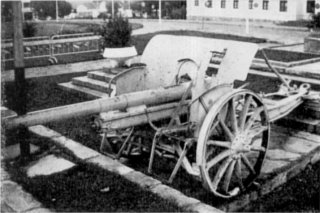
7.7 cm FK16 - this 1916 field gun
was made by Rheinmetall. It was mounted
on a light field howitzer carriage,
and its long barrel was distinctive.
| German designation: | 7,5 cm Feldkanone M 12 | (abbreviated: 7,5 cm FK M 06/12) |
| Weight of projectile: | 6,5 kg | (14,33 lb) |
| Muzzle velocity: | 510 m/sec | (1 673 ft/sec) |
| Calibre: | 7,5 cm | (2,95 in) |
| Maximum range: | 7 600 m | (8 311 yds) |
| Traverse: | 3,50 left and right | |
| Elevation: | -12° to | +18,5° |
| Weight in action: | 1 016 kg | (1 ton) |
Gun designers in many European countries were active at the beginning of the 20th Century, and there was much trading in artillery pieces. Ehrhardt of Germany has already been mentioned. Perhaps the most prominent designer of the period was Krupp of Germany. He produced several 7,5 cm field guns at this time. These were sold to Belgium, Holland, Turkey, Sweden, Denmark and Japan.
Other designers were Skoda of Bohemia, Cockerill of Belgium, Schneider of France, Armstrong and Vickers of Britain and Bethlehem of America.
This gun illustrates the practice well. Made by Krupp, it was sold to the Italian Army before World War I. It is typical of Krupp guns of the period. Firing a 6,5 kg shell 7 600 m, it was an effective weapon. The trail limited elevation to 18,5° and this restriction limited range as well.
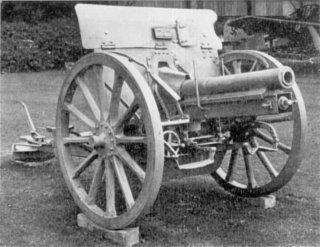
7.5 cm Field Gun Model 06/12 -
Designed by Krupp for the Italian Army,
this gun was used by the Italians
in both World Wars.
| German designation: | 10,5 cm leichtes Feldhaubitze M 98 |
(abbreviated: 10,5 cm le FH 98) |
| Weight of projectile: | 15,7 kg | (34,6 lb) |
| Muzzle velocity: | 302 m/sec | (991 ft/sec) |
| Calibre: | 10,5 cm | (4,13 in) | Maximum range: | 5 900 m | (6 452 yds) |
| Traverse: | Nil | |
| Elevation: | -10° to | +40° |
| Weight in action: | 1 090 kg | (1,1 tons) |
Note: A 12,8 kg (28,2 lb) shrapnel round was also available. Shrapnel range was 7 000 m (7 655 yds).
At the end of the 19th Century, the major powers were introducing field howitzers to provide a curved trajectory, high explosive shell, capability for their artillery. Initially, Germany was reluctant to take this line, believing that yet one more equipment would complicate her field artillery organisation. Consequently, an attempt was made to solve the problem by producing suitable ammunition for the field gun. This was not successful, so a new howitzer was rapidly produced.
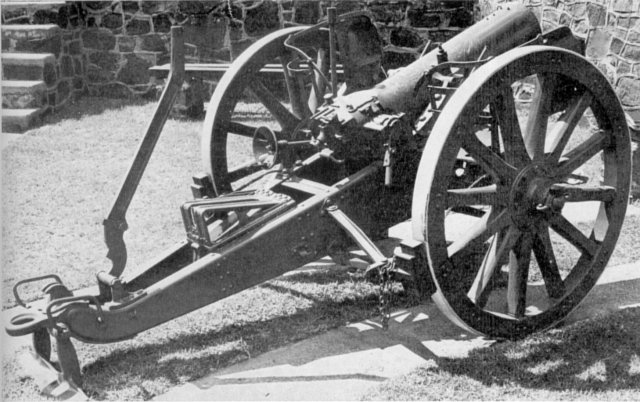
10.5 cm Light Field Howitzer Model 98 -
Rigidly mounted with no recoil system,
this howitzer was obsolete by 1914.
The Model 98 could not be traversed independently of the carriage. The rate of fire was slightly less than that of the field gun. Recoil arrangements were the same; i.e. a wire rope brake and a trail spade. There were seven charges and the muzzle velocity of 300 m/sec was achieved when all seven were fired.
South African troops encountered this gun in the German West campaign.
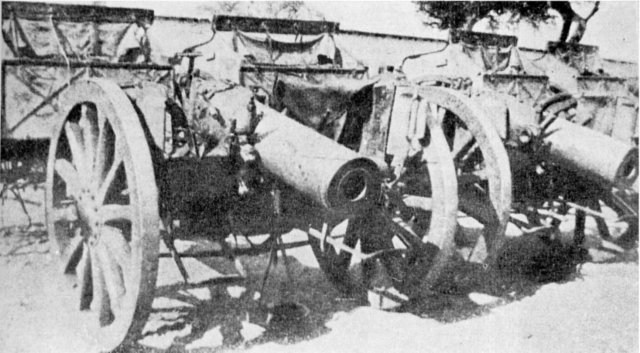
10.5 cm Light Field Howitzer Model 98 - In spite of
being obsolete this equipment
was used by the Germans in South West Africa.
These guns were captured at Otavifontein.
| German designation: | 10,5 cm leichtes Feldhaubitze M 98/09 |
(abbreviated: 10,5 cm le FH 98/09) |
| Weight of projectile: | 15,8 kg | (35 lb) |
| Muzzle velocity: | 302 m/sec | (991 ft/sec) |
| Calibre: | 10,5 cm | (4,13 in) | Maximum range: | 6 300 m | (6 890 yds) |
| Traverse: | 20 left and right | |
| Elevation: | -l0° to | +40° |
| Weight in action: | 1 225 kg | (1,2 tons) |
Just as it was necessary to modernize the 7,7 cm FK 96, so also was it necessary to improve the 10,5 cm Model 98. This equipment was entirely re-modelled and appeared as the Model 98/09 in good time for World War I. It was given a recoil system, the ability to traverse, a shield and a single motion breech mechanism.
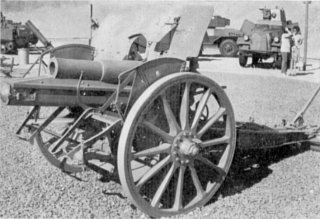
10.5 cm Light Field Howitzer Model 98/09 -
This was an improved version of the
light howitzer, incorporating a recoil system.
It was the standard equipment in 1914.
During the war, two new light field howitzers were introduced. These were mounted on the 98/09 carriage and had longer barrels and greater range.
| German designation: | 15 cm schweres Feldhaubitze M 93 |
(abbreviated: 15 cm sFH 93) |
| Weight of projectile: | 42 kg | (92,6 lb) |
| Muzzle velocity: | 280 m/sec | (921 ft/sec) |
| Calibre: | 14,97 cm | (5,9 in) |
| Maximum range: | 6 050 m | (6 638 yds) |
| Traverse: | Nil | |
| Elevation: | 0° to | +65° |
| Weight in action: | 2 189 kg | (2,2 tons) |
This was the heavy howitzer of Foot Artillery at the end of the 19th Century. It was replaced in the early 1900s but, although obsolete, some were still in use in 1914 in Reserve Artillery units and in German colonies abroad.
Like the 7,7 cm Model 96 and the 10,5 cm Model 98, this equipment was mounted on a rigid carriage and so had a violent action on firing. Recoil was checked by tyre brakes and it was normally fired from a platform. When a platform was not used, soft ground mats were placed under the wheels and trail in an attempt to ease the problem.
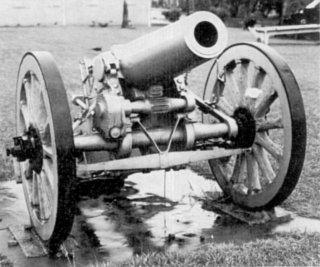
15 cm Heavy Field Howitzer Model 93 -
This was another[piece of] obsolete equipment
in 1914, but was nevertheless used
in the early days of the war.
| German designation: | 15 cm schweres Feldhaubitze M 02 |
(abbreviated: 15 cm sFH 02) |
| Weight of projectile: | 42 kg | (92,6 lb) |
| Muzzle velocity: | 325 m/sec | (1 066 ft/sec) |
| Calibre: | 14,97 cm | (5,9 in) |
| Maximum range: | 7 450 m | (8 147 yds) |
| Traverse: | 2° left and right | |
| Elevation: | 0° to | +42° |
| Weight in action: | 2 035 kg | (2 tons) |
Another development in the updating of German artillery in the first decade of the 20th Century, was the replacement by the 15 cm Model 02 of the Model 93 as the equipment of German Foot Artillery.
The Model 02 had a recoil system and spade but no shield was fitted. The barrel was longer than that of the Model 93 — 12 calibres compared with 10,8 calibres. As was normally the case when a recoil system was fitted, traverse (of 20 left and right) was provided, but elevation was limited to 42° compared with the 65° of the earlier model. It is interesting to note that the weight in action (2035 kg) was less than that of the Model 93 (2 189 kg).
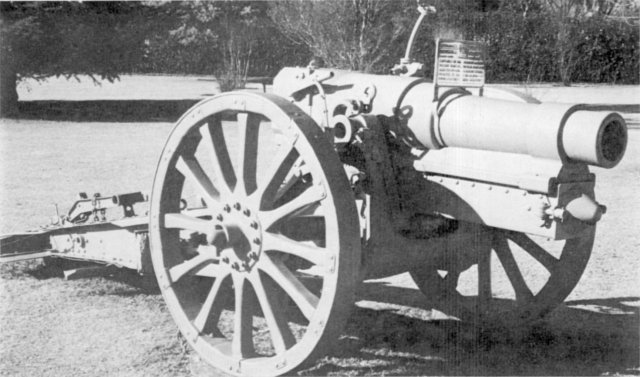
15 cm Heavy Field Howitzer Model 02 - This was an
improvement on the Model 93. It was better known
to British troops as the "Five Nine".
With a calibre of 5,9 inches, they were collectively known as ‘Five Nines’ to British troops.
| German designation: | 8,8cm Seekanone L/30 |
(abbreviated: 8,8cm SK L/30) |
| Weight of projectile: | 11,3 kg | (25 lb) |
| Calibre: | 8,8 cm | (3,46 in) |
The Germans in their African colonies were largely cut off from supplies from home, and this certainly applied to the force, under Colonel (later General) von Lettow Vorbeck, in East Africa. Every gun counted. Obsolete guns had to be used and even naval guns had to be pressed into service ashore.
8,8 cm and 10,5 cm guns were the standard equipments of the smaller ships of the German Navy at this time. One of these 8,8 cm guns now stands at Fort Klapperkop, near Pretoria. It came from the German light cruiser ‘Konigsberg’.
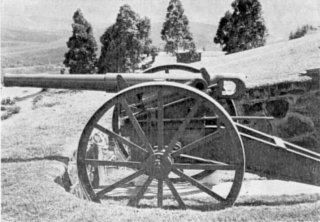
8.8 cm Naval Gun - Intended for
mounting on a German merchantman,
this gun was used ashore in German East Africa.
The gun’s original naval mounting can easily be recognised. It has a long barrel and must have had a high muzzle velocity. As mounted on its ad hoc carriage for field use, it had the ability to elevate but not to traverse. Traverse would have been possible in a normal ship’s mounting.
The gun was probably damaged before falling into enemy hands.
The story of the ‘Konigsberg’s’ guns is fascinating. This light cruiser was trapped in the Rufiji River in East Africa and was eventually destroyed by the Royal Navy. Earlier it had posed a considerable threat to Allied merchant shipping in the Indian Ocean. The search for the ‘Konigsberg’, the exploits of the famous South African hunter, Pieter Pretorius, and the ship’s eventual destruction are well worth reading about, but the story cannot be told here.
The ‘Konigsberg’s’ effectiveness did not end with its destruction. The Germans salvaged its ten 10,5 cm guns and used them throughout the rest of the campaign.
The gun standing in the grounds of the Union Buildings in Pretoria is described as having been captured at Kahe. This cannot be so. That gun was mounted on a wooden platform, not a wheeled carriage, and anyway was blown up by the Germans before they abandoned it.
The ‘Konigsberg’s’ guns were a vital addition to Von Lettow-Vorbeck’s artillery strength. The ship may have been destroyed in June 1915 but effectively it remained in action until the end of the campaign.
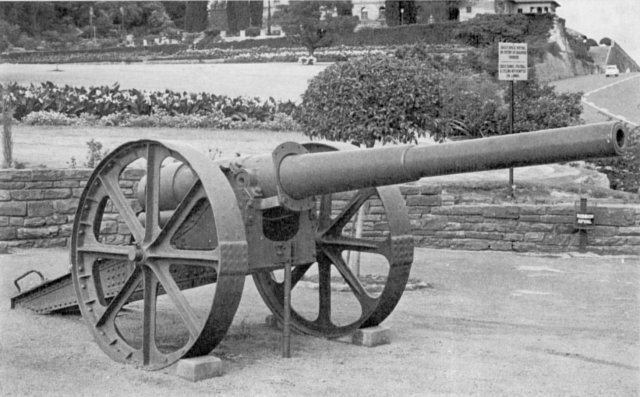
10.5 cm - This was one of the ten
'Konigsberg' guns which accompanied
von Lettow-Vorbeck's forces throughout
the German East African campaign.
| German designation: | 10,5 cm Seekanone | (abbreviated: 10,5 cm SK) |
| Weight of projectile: | 17,4 kg | (31 lb) |
| Muzzle velocity: | 600-650 m/sec | (1969-2132 ft/sec) |
| Calibre: | 10,5 cm | (4,13 in) |
| Maximum range: | 12 000 m approx | (13 123 yds approx) |
| Traverse: | Nil | |
| Elevation: | ? to | 38° approx |
| Weight in action: | 4 000 kg approx | (3,9 tons approx) |
REFERENCES
Taschenbuch der Artillerie — Kosar.
Modern Guns and Gunnery 1910 — Bethell.
Proceedings of the Royal Artillery Institution — Volumes XXVI and XXVIII.
Das Ehrenbuch der Deutschen Feldartillerie 1914-1918.
Jane’s Fighting Ships
7,7 cm Feldkanone 96 n/A (Modelworld Jan 1973) — Thurston.
ACKNOWLEDGEMENTS
The author is indebted to Mr K. Moeller of Swakopmund and Oberstleutnant H. Kosmale of Idar-Oberstein, Federal Republic of Germany, for their assistance, and to Mr and Mrs F. van Rooyen of Windhoek for their photographs of the 7 cm Krupp mountain gun and the 8 cm Model C/73.
LOCATION OF GERMAN WORLD WAR I GUNS
| Type | Location | Number |
| 3,7 cm Automatic Machine Gun Pom-pom | Fort Klapperkop, Pretoria | 1 |
| 7 cm Mountain Gun Model 98 | Government Buildings, Windhoek | 2 |
| 7,5 cm Mountain Gun Model 08 | Union Buildings, Pretoria | 3 |
| Warriors’ Gate, Durban | 2 | |
| Bloemfontein | 2 | |
| War Memorial, Ermelo | 1 | |
| War Museum, Windhoek | 1 | |
| 8 cm Light Field Gun Model C/73 | Government Buildings, Windhoek | 1 |
| Francke Memorial, Omaruru | 1 | |
| 9 cm Field Gun Model C/73/88 | Cinderella Prison, Boksburg | 1 |
| 7,7 cm Field Gun Model 96 | War Memorial, Pietermaritzburg | 2 |
| Law Courts, Johannesburg | 2 | |
| Pietersburg | 2 | |
| 7,7 cm Field Gun Model 96 n.A. | War Memorial, Pietermaritzburg | 2 |
| Town Hall, Ladysmith | 2 | |
| Fort Klapperkop, Pretoria | 1 | |
| 7,7 cm Field Gun Model 16 | War Memorial, Krugersdorp | 1 |
| 7,5 cm Field Gun Model 06/12 | SA National War Museum, Johannesburg | 1 |
| 10,5 cm Light Field Howitzer Model 98 | Fort Klapperkop, Pretoria | 1 |
| Joubert Park, Johannesburg | 1 | |
| 10,5 cm Light Field Howitzer Model 98/09 | Fort Klapperkop, Pretoria | 1 |
| 15 cm Heavy Field Howitzer Model 93 | Fort Napier, Pietermaritzburg | 1 |
| Pretoria | 1 | |
| 15 cm Heavy Field Howitzer Model 02 | SA National War Museum, Johannesburg | 2 |
| Fort Klapperkop, Pretoria | 1 | |
| 8,8 cm Naval Gun | Fort Klapperkop, Pretoria | 1 |
| 10,5 cm Naval Gun | Union Buildings, Pretoria | 1 |
This e-mail was received in late April 2006:
I happened to read your paper "German Guns of World War I in South Africa", Military History Journal - Vol. 3 No. 2 on the internat[sic] page of the South African Military History Society. Apparently, there are still some Königsberg Naval guns designated as "SK". You write that this abbreviation would mean "Seekanone" [Sea Gun or Naval Gun].
This is wrong.
When quick fire guns were introduced into the European Navies in the early 1890ies, Germany followed suit. However, the Inspector of Naval Artillery, Admiral August von der Lieth-Thomsen wanted to prevent squandering of ammunition and to stress the fact that in order to hit the enemy even with quick firing guns it was still necessary to take careful aim. So, "Schnellfeuerkanone" [Quick Fire Gun] was rejected and "Schnellladekanone" [Quick Loading Gun] adopted, abbreviated "SK".
Dr. Dirk Rottgardt
Berlin, Germany
Return to Journal Index OR Society's Home page
South African Military History Society / scribe@samilitaryhistory.org